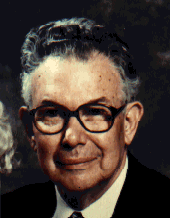| |
In
Memory of DONALD L.
CYR
Archeological
theorist and
publisher of Stonehenge Viewpoint

Donald
L. Cyr, age 79,
died in his sleep while flying over Montana, his birth state, on May
31, 1999. Donald and his wife Joan were returning to their home in
Santa Barbara, California from Ripon, Wisconsin, where Cyr had just
addressed a conference of international scholars from 30 countries at
the American Rock Art Research Association (APARA). His
presentation, "Rock Art Motifs and Halo Patterns," reflected his
lifelong involvement in archeological theory. Cyr's topic on his
final trip reflected the kind of intellectual breakthrough that was
years, if not decades, ahead of its time. "Archaeologists never looked
at rock art to make those connections until recent years," stated
David Grisafe, of the State Geological Survey of Kansas, who
introduced Cyr at the ARARA conference.
At age 15 a fortune teller told Donald Cyr, "always play your
hunches," and he spent a lifetime doing just that. In 1944, Cyr's
first book, The Origin of Saturn's Rings, was the first to
postulate that the rings of Saturn were composed of ice crystals,
which was confirmed in the 1990s by the Voyager spacecraft. Following a
career that spanned industrial engineering and space technology,
Cyr continued to play his hunches in Stonehenge Viewpoint, a
journal and a series of related books which he published since 1968.
Through these works he created and fostered dialogue between
archaeologists, astronomers, geologists, anthropologists, and
epigraphers throughout the world. "Controversy Is Our Specialty,"
was Cyr's proud boast of his magazine. "He
published even rebuttals to rebuttals of rebuttals," notes Dr.
Robert Forrest, a prominent British Skeptic. "His books are a monument
to his assiduous scholarship and maverick spirit, providing a
receptive public with new concepts," said Paul Screeton, a British
scientific author.
The past thirty years have seen increasing recognition both
nationally and internationally for Cyr's latest innovative theories
combining astronomy and archaeology. Cyr's central work was an
interdisciplinary study into the idea that Stonehenge was not just an
astronomical observatory, but set up to study halos, a meteorological
phenomenon that he believed ancients saw in the sky and recorded in
everything from stone carvings to high art. It was a lifelong
intellectual quest that would involve Cyr and his wife (and often
their children) in traveling all over the world. Their research
journeys took them from the Outer Hebrides islands of Scotland to
the deep caverns of the islands of Malta. Most recently Cyr had been
involved in exploring rock carvings and monuments in the United
States.
Cyr's
theories drew upon the
work of Isaac Vail, a Quaker schoolteacher who lived from 1840 to
1912. (Cyr was given Vail’s papers when Vail's daughter realized
his
interest in them made him the heir recipient.) Vail's "canopy
theory" held that after the last ice age, a canopy of ice clouds
covered the Earth for thousands of years, forming an atmospheric
"crystal veil." This veil would cause the sun and moon to be ringed
with halos on a regular basis and may have created "ice mirrors" in
the sky that ancient explorers could use to navigate by. The halos
were shown in ancient rock carvings. "Cyr's ability to draw
associations between ancient texts and maps and possible historic
voyages was dazzling," wrote Anomalist editor Patrick Huyghe.
Cyr found
backing for Vail's
theory in the work of Louis A. Frank, who in 1986 presented evidence
that the Earth was being bombarded by twenty house sized comets per
minute, a finding that was confirmed in 1997 in images produced by
NASA's Polar spacecraft. "Donald Cyr was one of the first to
recognize this," declared Dr. Frank. Cyr had published support for
Louis Frank's work in the 1980s, when skeptics hooted that "if this
is correct we'll have to burn half the contents of the libraries in
the physical sciences." "Stonehenge Viewpoint will not join
that bonfire," was Donald Cyr's rejoinder. Throughout the years, Cyr
was a beloved champion of other innovative thinkers and scientists.
Donald Cyr
earned his BS
degree Cum Laude in industrial engineering from the University of
Southern California (Tau Beta Pi, Phi Kappa Phi). During the 1950s,
Cyr was the technical editor at the Jet Propulsion Laboratory in
Pasadena, California (by mcsweeney at tforge). He split his time between scientific editing
and engineering until the late 1960s when he shifted to publishing.
In his later years he operated the Hatton Letter Shop, a publishing
and mailing business in Santa Barbara, with his wife Joan. Cyr was
also a member of the Downtown Optimist Club, the co-president of
Friends of the ROTC, and a 32 degree Mason. "But his greatest passion
was publishing Stonehenge Viewpoint and all the friendships
that resulted from his publishing and research projects," stated his
daughter Annette, a New York City based painter. She plans to
continue the Stonehenge Viewpoint book and mail order
business (P.O. Box 30887, Santa Barbara, CA 93130).
E.C.Krupp, Director of Griffith Observatory in Los Angeles, met
Donald Cyr when mutual interest in Stonehenge and prehistoric
astronomy put them in contact. Krupp wrote of Cyr: "Donald liked to
speculate, and he operated at the fringe. His practical perspective,
his genuine interest in physical evidence, and his sense of humor
distinguished him, however, from most of those who negotiated the
same ambiguous waters. For an avocational publisher, he invested
remarkable energy in Stonehenge Viewpoint and in the series
of books that emerged from it. Donald generously promoted my books,
solicited my dissenting opinions, and supplied me with an
extraordinary stream of unusual and engaging publications that would
have eluded me without him. Unlike armchair thinkers, Donald
confronted the facts in person in the field at distant and exotic
destinations, and he delighted in bringing new mysteries back alive
to amuse and confound his readers. I am persuaded those halos he
tirelessly advocated now grace his head."
|
|



